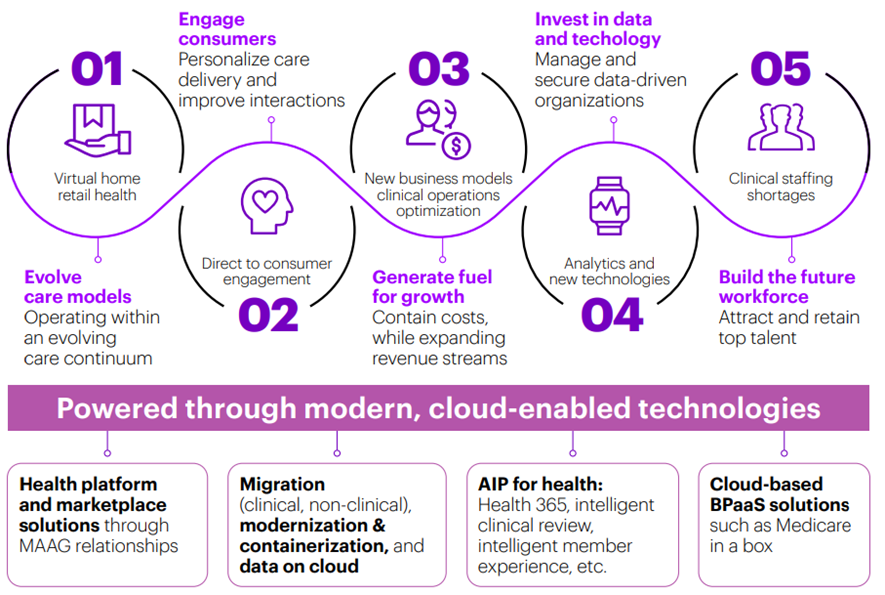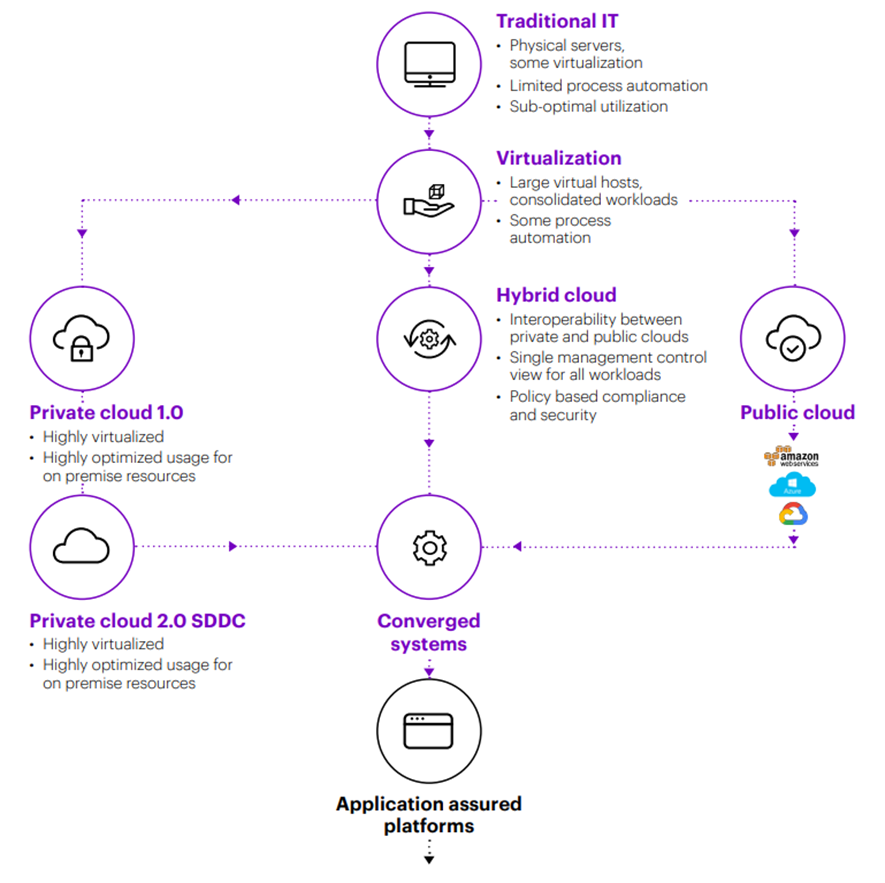This is an excerpt of the publication “The cloud imperative in healthcare”, with the title above, focusing on the topic in question. For the full version of the article, please refer to the original publication.
2021
Chris D’hondt ; Sanjay J. Mehta; Oleg Kucheryavenko, MD, MPH ;
David Wood
Executive Summary
by Joaquim Cardoso MSc.
Health Transformation — Institute
Multidisciplinary Institute for Continuous Transformation in Health and Care
June 10, 2022
Structure of the original publication
Cloud is not new in healthcare
The path forward
- Cloud is a powerful business enabler and a springboard to the future.
- Key business priorities are accelerating cloud in healthcare
- The traditional data center approach has matured over time to include various forms of cloud
Why cloud now?
- Business leaders have a stake in cloud
- Cloud service providers are prioritizing the healthcare industry
- Public cloud unlocks new value — and reduces costs
- Public cloud is more secure by default
Moving to action
- How do we organize around cloud?
- How do we drive change quickly despite complex legacy systems and technical debt?
- How do we need to think about value to stakeholders?
Conclusion

EXCERPT 2.1
The path forward
- Cloud is a powerful business enabler and a springboard to the future.
- Key business priorities are accelerating cloud in healthcare
- The traditional data center approach has matured over time to include various forms of cloud
Cloud is a powerful business enabler and a springboard to the future.
So it’s no surprise that 79% of healthcare stakeholders responded to a survey last summer saying that they would make cloud a strategic priority in 2020.[3] And that was months before COVID-19.
While every healthcare organization is unique — and the payer and provider segments have specific market, customer and competitive dynamics — there are fundamental business priorities that all healthcare organizations should address to succeed.

Key business priorities are accelerating cloud in healthcare

Cloud is the common denominator for the “how” of achieving all these business priorities.
Every one of them is powered through modern, cloud-enabled technologies.
Over the next three to five years, healthcare organizations will embrace hybrid cloud solutions as they modernize toward public cloud.
Over the next three to five years, healthcare organizations will embrace hybrid cloud solutions as they modernize toward public cloud.
As industry players begin their journey to cloud, most will initially land on a hybrid cloud strategy with application and data workloads balanced across both public and private clouds.
This is a “best of both worlds” approach that offers low latency for some workloads that live in the private cloud while simultaneously creating opportunity to innovate at scale — via AI, cognitive services, blockchain and more — in the public cloud.
Think of it as combining the public cloud benefits of innovation and speed with the private cloud benefits of regulatory compliance and performance.
However, the most progressive healthcare organizations will move beyond a hybrid cloud strategy and accelerate the move to the public cloud.
After all, this is where the most business and technology value lies.
There is tremendous opportunity for healthcare organizations to tap into a full range of cloud-native services.
In fact, many services are already HIPAA-compliant, and if configured appropriately, can be — and are — used in public cloud architectures.
As industry players begin their journey to cloud, most will initially land on a hybrid cloud strategy with application and data workloads balanced across both public and private clouds.
However, the most progressive healthcare organizations will move beyond a hybrid cloud strategy and accelerate the move to the public cloud.
Why is public cloud the ultimate destination?
The reality is that the industry’s new business models require elements like streaming and processing data, connected IoT devices and platform plays with ecosystem partners.
All of these require the speed and scale that’s only offered in the public cloud.
The reality is that the industry’s new business models require elements like streaming and processing data, connected IoT devices and platform plays with ecosystem partners.
All of these require the speed and scale that’s only offered in the public cloud.

The traditional data center approach has matured over time to include various forms of cloud

In essence, the path to the future of healthcare runs through the public cloud.
- While 18 months ago the industry’s top concern involved what capabilities companies needed in the cloud and the best way to control public cloud use,
- today’s critical issue is how to compete in wildly uncharted territory if the business doesn’t successfully scale cloud.
In essence, the path to the future of healthcare runs through the public cloud.
EXCERPTED FROM
The cloud imperative in healthcare
2021
Chris D’hondt ; Sanjay J. Mehta;
Oleg Kucheryavenko, MD, MPH ; David Wood, accenture

EXCERPT 2.2
Moving to action
There is a big difference between aspiring to scale cloud and acting to make it happen.
For healthcare organizations to expand investments in public cloud, they need to answer three common questions.
- How do we organize around cloud?
- How do we drive change quickly despite complex legacy systems and technical debt?
- How do we need to think about value to stakeholders?
1.How do we organize around cloud?
A new, cloud operating model is required. It’s necessary to drive collaboration across various IT and business domains that have historically been very siloed. Without the right level of senior, cross-functional engagement, organizations cannot realize the full potential of cloud and will struggle to drive change. Given the regulatory, legal and contractual commitments that healthcare organizations face related to protecting health information and personally identifiable information, aligning these teams and building a common understanding of the need to protect and secure data in the cloud in line with policies and regulations is key to success.
2.How do we drive change quickly despite complex legacy systems and technical debt?
While modernizing the legacy is costly and highly complex, healthcare organizations do not have to be overwhelmed by tackling such a monumental challenge. A more reasonable approach is to focus on modernizing key capabilities that drive the experiences that are priorities for reinvention. There is no need to do it all at once. Healthcare organizations can decouple these priority capabilities from the legacy (claims, benefits, EHR systems) to enable easier access to the data to drive insights and new digital experiences. Companies should never fund large, multi-year modernization programs without significant interim milestones.
3.How do we need to think about value to stakeholders?
Today, only about 18% of healthcare IT leaders have engaged non-IT executives on cloud issues or involved them in cloud strategy discussions.[7] This must change. As healthcare organizations aggressively pursue their cloud strategies, it is critical to engage leaders beyond traditional IT executives to sponsor the transformation. After all, the “buyer” is no longer simply a CIO or an infrastructure leader. And the business case is not just about cost, it is about business value and growth.

Conclusion
Cloud is on the move in healthcare. In fact, 97% of industry leaders — compared to just half of laggards — are leveraging cloud-based capabilities.[8] Yet scaling cloud successfully requires new muscle.
It requires healthcare organizations to marshal a new way of architecting, governing, managing and measuring how technology is “consumed.”
The question is no longer about “why” healthcare needs cloud.
It’s about how to scale it at a time when the dynamics of the industry are evolving fast.












